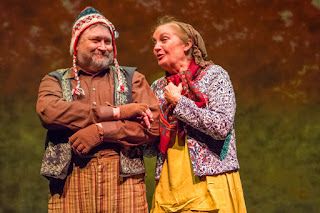Published in
the Weekly Volcano, May 27, 2016
NW Art Now at
Tacoma Art Museum is a big, colorful, and cutting-edge
| “Orca Pod,” oil on canvas, by Karen Hackenberg, courtesy of the artist |
exhibition of
new and recent works by 24 regional artists. Included are 47 works in a wide
range of media, including painting, sculpture, craft-based work, as well as
conceptual, performance, installation, and digital projects. One of the more
cutting-edge and/or conceptual aspects to the show is that a number of pieces
are displayed outside the galleries, some in places where you might not even
see them unless you diligently search them out. For instance, Dylan Neuwirth’s
“Just Be Your Selfie,” a neon installation that hung over Pioneer Square in
Seattle, now hangs high over the entrance canopy
at TAM; and Lou Watson’s “Section of the I-705, on a Wednesday, for Electric
Piano” is an audio and visual projection of a musical score based on the
frequency and colors of cars passing by as filmed from the museum, displayed on
the wall where visitors enter from the garage.
Much
of the show deals with issues of identity, social justice and the environment,
and there are hard-hitting feminist and racial statements and works that
explore media or combinations of media in innovative ways. The conceptual
pieces are exactly what the name “conceptual” implies: art that may be more
interesting to think about than to look at. And there are works that meld
concept with image in beautiful and thought-provoking ways. Among these are two
video projections by C. Davida Ingram, Seattle performance artist and winner of
the 2014 Stranger Genius Award. Projected in alternating sequences are “The
Deeps: Go Away from My Window” and “Procession” (a video installation with
drone footage of four black women in hooded white gowns at the historical King
Street station in Seattle). These, especially “Procession,” are among the more
haunting videos I have ever seen.
| "M is for Mak'Lak, W is for White" authentic NDN design, oil on linen by Ka'ila Faqrrell-Smith, courtesy of the artist. |
Ka’ ila
Farrell-Smith has paintings in the show that combine Native American traditions
with abstract-expressionist paint application. In a statement on her website at
http://www.kailafarrellsmith.com/, she writes, “I search for my visual language: violent, beautiful, and
complicated marks that express my contemporary Indigenous identity.” Hard-edge
precision,
layering, scratching and splattering are interwoven in shallow spatial
movement in her paintings “M is for Mak’Lak,
W is for White” and “Noo’a Eqksil’ini.”
Juventino
Aranda’s three paintings in oil stick on wool mimic patterns of woven Native
American blankets with floating bars of color reminiscent of Mark Rothko, which
are homages to and, at the same time, lampoons of each. The texture and edge
quality of the oil stick on wool is stunningly beautiful.
There
is an impressive number of Tacoma artists in the show including Oliver
Doriss, Christopher Paul Jordan, Jeremy Mangan, Asia Tail, Jamie Marie
Waelchli, and John Sutton of SuttonBeresCuller,
who was born in Tacoma and today lives in Seattle.
Doriss’s “Alpine Panel Study #1” is cast glass
with silver botanical inclusions, a unique and richly textured forest in glass
in the shape of Mt. Rainer. Mangan is represented with two hyper-realistic oil
paintings of scenes that do not and probably never could exist in nature. “Even
on the Most Still Days” depicts clever smoke writing over water, and “Pacific
Northwest Desert Island” pictures a floating island with tall trees, a little
lean-to and a campfire. The jewel-like painting of reflections in rippling
water is stunningly beautiful.
I could go on and on describing the rich variety of art in this show.
TAM has done many juried shows of Northwest art. Perhaps my memory of previous
shows is not to be trusted, but I’m pretty sure this is the best one yet.
NW Art Now, Tuesday-Sunday, 10 a.m. to 5 p.m., through Sept. 4, closed Memorial
Day, $12-$14, Tacoma Art Museum, 1701 Pacific Ave. Tacoma,
http://www.tacomaartmuseum.org/

















